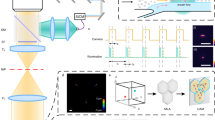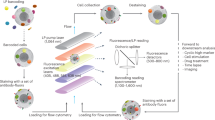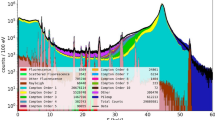Abstract
Flow cytometry allows quantitative analysis of the identity and effector function of individual cells. However, it cannot provide information on cellular responses that occur within physiological tissue microenvironments. Laser scanning cytometry is an emerging technology that allows imaging and quantitative analysis of individual cells in tissues in situ. This article describes the technology and its potential for delineating the molecular and cellular events underpinning the immune response in health and disease.
This is a preview of subscription content, access via your institution
Access options
Subscribe to this journal
Receive 12 print issues and online access
$209.00 per year
only $17.42 per issue
Buy this article
- Purchase on Springer Link
- Instant access to full article PDF
Prices may be subject to local taxes which are calculated during checkout



Similar content being viewed by others
References
Grierson, A. M. et al. Direct quantitation of T cell signaling by laser scanning cytometry. J. Immunol. Methods 301, 140–153 (2005).
Pozarowski, P., Holden, E. & Darzynkiewicz, Z. Laser scanning cytometry: principles and applications. Methods Mol. Biol. 319, 165–192 (2006).
Gerstner, A. O. et al. Quantitative histology by multicolor slide-based cytometry. Cytometry A 59, 210–219 (2004).
Tarnok, A. & Gerstner, A. O. Clinical applications of laser scanning cytometry. Cytometry 50, 133–143 (2002).
Mittag, A. et al. Polychromatic (eight-color) slide-based cytometry for the phenotyping of leukocyte, NK, and NKT subsets. Cytometry A 65, 103–115 (2005).
Mittag, A., Lenz, D., Gerstner, A. O. & Tarnok, A. Hyperchromatic cytometry principles for cytomics using slide based cytometry. Cytometry A 69, 691–703 (2006).
Luther, E., Kamentsky, L., Henriksen, M. & Holden, E. Next-generation laser scanning cytometry. Methods Cell Biol. 75, 185–218 (2004).
Kamentsky, L. A. & Kamentsky, L. D. Microscope-based multiparameter laser scanning cytometer yielding data comparable to flow cytometry data. Cytometry 12, 381–387 (1991).
Rew, D. A., Woltmann, G. & Kaur, D. Near-clinical applications of laser scanning cytometry. Methods Mol. Biol. 319, 193–212 (2006).
Mittag, A. et al. Sequential photobleaching of fluorochromes for polychromatic slide-based cytometry. Cytometry A 69, 139–141 (2006).
Gerstner, A. O. et al. Comparison of immunophenotyping by slide-based cytometry and by flow cytometry. J. Immunol. Methods 311, 130–138 (2006).
Dey, P. Role of ancillary techniques in diagnosing and subclassifying non-Hodgkin's lymphomas on fine needle aspiration cytology. Cytopathology 17, 275–287 (2006).
Holme, A. L., Yadav, S. K. & Pervaiz, S. Automated laser scanning cytometry: a powerful tool for multi-parameter analysis of drug-induced apoptosis. Cytometry A 71, 80–86 (2007).
Laffers, W., Mittag, A., Lenz, D., Tarnok, A. & Gerstner, A. O. Iterative restaining as a pivotal tool for n-color immunophenotyping by slide-based cytometry. Cytometry A 69, 127–130 (2006).
Bocsi, J. et al. Novel aspects of systems biology and clinical cytomics. Cytometry A 69, 105–108 (2006).
Gerstner, A. O. et al. Preoperative detection of laryngeal cancer in mucosal swabs by slide-based cytometry. Eur. J. Cancer 41, 445–452 (2005).
Gerstner, A. O. et al. Prediction of upper aerodigestive tract cancer by slide-based cytometry. Cytometry A 69, 582–587 (2006).
Kornblau, S. M. et al. Studying the right cell in acute myelogenous leukemia: dynamic changes of apoptosis and signal transduction pathway protein expression in chemotherapy resistant ex-vivo selected “survivor cells”. Cell Cycle 5, 2769–2777 (2006).
Taatjes, D. J., Zuber, C. & Roth, J. The histochemistry and cell biology vade mecum: a review of 2005–2006. Histochem. Cell Biol. 126, 743–788 (2006).
Adams, C. L., Grierson, A. M., Mowat, A. M., Harnett, M. M. & Garside, P. Differences in the kinetics, amplitude, and localization of ERK activation in anergy and priming revealed at the level of individual primary T cells by laser scanning cytometry. J. Immunol. Methods 173, 1579–1586 (2004).
Marshall, F. A., Grierson, A. M., Garside, P., Harnett, W. & Harnett, M. M. ES-62, an immunomodulator secreted by filarial nematodes, suppresses clonal expansion and modifies effector function of heterologous antigen-specific T cells in vivo. J. Immunol. 175, 5817–5826 (2005).
Smith, K. M., Brewer, J. M., Rush, C. M., Riley, J. & Garside, P. In vivo generated Th1 cells can migrate to B cell follicles to support B cell responses. J. Immunol. 173, 1640–1646 (2004).
Taatjes, D. J. et al. Laser-based microscopic approaches: application to cell signaling in environmental lung disease. Biotechniques 31, 880–882, 884, 886–888, 890, 892–894 (2001).
Garside, P. E. et al. Visualization of specific B and T lymphocyte interactions in the lymph node. Science 281, 96–99 (1998).
Pape, K. A. et al. Use of adoptive transfer of T-cell antigen-receptor-transgenic T cell for the study of T-cell activation in vivo. Immunol. Rev. 156, 67–78 (1997).
Croxford, J. L., Miyake, S., Huang, Y. Y., Shimamura, M. & Yamamura, T. Invariant Vα19i T cells regulate autoimmune inflammation. Nature Immunol. 7, 987–994 (2006).
Jarman, E. R., Tan, K. A. & Lamb, J. R. Transgenic mice expressing the T cell antigen receptor specific for an immunodominant epitope of a major allergen of house dust mite develop an asthmatic phenotype on exposure of the airways to allergen. Clin. Exp. Allergy 35, 960–969 (2005).
Maffia, P. et al. Inducing experimental arthritis and breaking self-tolerance to joint-specific antigens with trackable, ovalbumin-specific T cells. J. Immunol. 173, 151–156 (2004).
Osman, G. E. et al. Expression of a type II collagen-specific TCR transgene accelerates the onset of arthritis in mice. Int. Immunol. 10, 1613–1622 (1998).
Bettelli, E., Baeten, D., Jager, A., Sobel, R. A. & Kuchroo, V. K. Myelin oligodendrocyte glycoprotein-specific T and B cells cooperate to induce a Devic-like disease in mice. J. Clin. Invest. 116, 2393–2402 (2006).
Amend, B. et al. Induction of autoimmunity by expansion of autoreactive CD4+CD62Llow cells in vivo. J. Immunol. 177, 4384–4390 (2006).
Huang, J. C., Vestberg, M., Minguela, A., Holmdahl, R. & Ward, E. S. Analysis of autoreactive T cells associated with murine collagen-induced arthritis using peptide-MHC multimers. Int. Immunol. 16, 283–293 (2004).
Korn, T. et al. Myelin-specific regulatory T cells accumulate in the CNS but fail to control autoimmune inflammation. Nature Med. 13, 423–431 (2007).
Fang, W. et al. Self-reactive B lymphocytes overexpressing Bcl-xL escape negative selection and are tolerized by clonal anergy and receptor editing. Immunity 9, 35–45 (1998).
Krutzik, P. O. & Nolan, G. P. Fluorescent cell barcoding in flow cytometry allows high-throughput drug screening and signaling profiling. Nature Methods 3, 361–368 (2006).
Wilson, E. H. et al. Hyporesponsiveness of murine B lymphocytes exposed to the filarial nematode secreted product ES-62 in vivo. Immunology 109, 238–245 (2003).
Parsons, C. H. et al. KSHV targets multiple leukocyte lineages during long-term productive infection in NOD/SCID mice. J. Clin. Invest. 116, 1963–1973 (2006).
Fanning, S. L. et al. Receptor cross-linking on human plasmacytoid dendritic cells leads to the regulation of IFN-α production. J. Immunol. 177, 5829–5839 (2006).
Arechiga, A. F. et al. Cutting edge: FADD is not required for antigen receptor-mediated NF-κB activation. J. Immunol. 175, 7800–7804 (2005).
Perfetto, S. P., Chattopadhyay, P. K. & Roederer, M. Seventeen-colour flow cytometry: unravelling the immune system. Nature Rev. Immunol. 4, 648–655 (2004).
Schubert, W. A three-symbol code for organized proteomes based on cyclical imaging of protein locations. Cytometry A 71, 352–360 (2007).
Butt, O. I., Krishnan, P., Kulkarni, S. S., Moldovan, L. & Moldovan, N. I. Quantification and functional analysis of chemotaxis by laser scanning cytometry. Cytometry A 64, 10–15 (2005).
Doyle, S. E. et al. Toll-like receptors induce a phagocytic gene program through p38. J. Exp. Med. 199, 81–90 (2004).
Koo, M. K., Oh, C. H., Holme, A. L. & Pervaiz, S. Simultaneous analysis of steady-state intracellular pH and cell morphology by automated laser scanning cytometry. Cytometry A 71, 87–93 (2007).
Mital, J., Schwarz, J., Taatjes, D. J. & Ward, G. E. Laser scanning cytometer-based assays for measuring host cell attachment and invasion by the human pathogen Toxoplasma gondii. Cytometry A 69, 13–19 (2006).
Hanania, E. G. et al. Automated in situ measurement of cell-specific antibody secretion and laser-mediated purification for rapid cloning of highly-secreting producers. Biotechnol. Bioeng. 91, 872–876 (2005).
Szaniszlo, P. et al. Scanning cytometry with a LEAP: laser-enabled analysis and processing of live cells in situ. Cytometry A 69, 641–651 (2006).
Ecker, R. C. & Tarnok, A. Cytomics goes 3D: toward tissomics. Cytometry A 65, 1–3 (2005).
Mosch, B., Mittag, A., Lenz, D., Arendt, T. & Tarnok, A. Laser scanning cytometry in human brain slices. Cytometry A 69, 135–138 (2006).
Mosch, B. et al. Aneuploidy and DNA replication in the normal human brain and Alzheimer's disease. J. Neurosci. 27, 6859–6867 (2007).
Jaiswal, J. K., Mattoussi, H., Mauro, J. M. & Simon, S. M. Long-term multiple color imaging of live cells using quantum dot bioconjugates. Nature Biotechnol. 21, 47–51 (2003).
Acknowledgements
I would like to thank A. Morton for generating the cellular and tissue images used in this article and the Medical Research Council for funding this research. I would also like to thank W. Harnett for constructive discussion relating to the manuscript.
Author information
Authors and Affiliations
Ethics declarations
Competing interests
The author declares no competing financial interests.
Supplementary information
Supplementary information S1 (table)
Comparison of applications and properties of LSC versus FCM and FIA (PDF 230 kb)
Related links
Glossary
- Background contour
-
The contour that is set on an unstained region to calculate the background fluorescence so that it can be subtracted from the real signal.
- Collimated laser beam
-
Light that is collimated has parallel rays. A laser beam on its formation is almost collimated but its beam radius always tends to increase with the distance from the laser's source. A collimated laser beam is one which is optimized to have an even lower light divergence such that the beam radius does not change significantly over the propagation distance. The use of such laser beams in laser scanning cytometry allows the analysis of depths of field of typically 20–30 μm.
- Differential photobleaching
-
Differential photostability of dyes of similar emission spectra can be exploited to generate virtual colours. Therefore, in the first scan, photostable (for example, Alexa 532) and conventional (for example, phycoerythrin) stains on different antigens cannot be distinguished, but, following photobleaching, two populations appear that can be identified by reference to pre- and post-bleaching analysis.
- Holmes effect
-
The cell overlap that occurs because of the inability to generate tissue sections of infinite thinness. This overlap results in inaccuracies in detecting frequencies and spatial characteristics of individual cell populations.
- Integration contour
-
The contour defined by the edge of the cell, which can be set either by an optimal number of pixels representing the cell size and/or by cell-surface staining.
- Iterative staining
-
Sequential staining using different antibodies but with the same fluorochrome allows identical colours to appear as distinct parameters (that is 'virtual colours') when newly labelled cells appear during sequential stains. During iterative staining, each cell serves as its own unstained control and a bleaching step before each re-staining can be included to improve sensitivity. Moreover, the use of the same fluorochrome reduces the need for compensation.
- Multiple thresholding
-
The scanning of tissue at a single threshold value of, for example, nuclear staining may not detect all relevant cells, whereas repeated analysis at different threshold levels compensates for inaccuracies in detecting cells of different diameters and cell density across the section. Merging of the multiple threshold scan files by laser scanning cytometry software allows all cells recognized at the same x–y-coordinates to be analysed as a single cell, thereby providing a more accurate analysis.
- Peripheral contours
-
The contours that are set 1 pixel out from the threshold contour (for example, the nucleus) and 1 pixel in from the integration contour (for example, the edge of cell) to allow analysis of staining within this region.
- Phantom contours
-
These comprise a lattice of contours over the tissue which recognizes pixels within the contours as cells, thereby generating information on the mean fluorescence intensity of such staining within the tissue rather than on an individual cell basis.
- Photoactivation
-
Quantum dot fluorescence intensity can be increased by laser exposure allowing generation of new virtual colours by analogous analysis to that used for differential photobleaching.
- Photodestruction of tandem dyes
-
Virtual colours can be generated by laser-induced photodestruction of the fluorescence resonance energy transfer (FRET) between the donor and acceptor fluorochromes of tandem dyes.
- Quantum dots
-
Semiconductor nanocrystals that have stable, discrete quantized energy spectra and fluoresce following exposure to light. They can therefore be used as fluorochrome tags on molecules such as antibodies to visualize molecular and cellular interactions.
- Threshold contour
-
The contour that is set to detect individual cells typically on the basis of their nuclear DNA staining.
- Tissue map
-
A map generated from the plotting of the precise x–y-coordinates and the emitted fluorescence obtained by laser scanning cytometry of each detected cell in a tissue sample. Tissue maps allow the visualization and quantitative analysis of the molecular and cellular interactions that occur within tissues.
Rights and permissions
About this article
Cite this article
Harnett, M. Laser scanning cytometry: understanding the immune system in situ. Nat Rev Immunol 7, 897–904 (2007). https://doi.org/10.1038/nri2188
Issue Date:
DOI: https://doi.org/10.1038/nri2188
This article is cited by
-
Multiplexed ion beam imaging (MIBI) for characterization of the tumor microenvironment across tumor types
Laboratory Investigation (2020)
-
White spot syndrome virus entry is dependent on multiple endocytic routes and strongly facilitated by Cq-GABARAP in a CME-dependent manner
Scientific Reports (2016)
-
High-throughput, multiparameter analysis of single cells
Analytical and Bioanalytical Chemistry (2014)
-
Haematopoietic stem cell niches: new insights inspire new questions
The EMBO Journal (2013)
-
Quantitative imaging of haematopoietic stem and progenitor cell localization and hypoxic status in the bone marrow microenvironment
Nature Cell Biology (2013)



